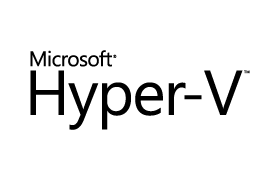Although the performance of input-output of SCSI and IDE physical devices may substantially differ, it does not touch upon virtualized in Hyper-V SCSI and IDE devices. Hyper-V. IDE and SCSI devices offer same high performance of input-output, if Integration Services are installed in the Guest Operating System.
Types of Virtual Hard Disks (VHD)
Hyper-V virtual machine can use three types of Virtual Hard Disks. All the types represent an ordinary file located in NTFS volume.
Detailed description of the types:
Dynamically Expanding Disk. This disk is used by default upon creation of a virtual machine. A virtual machine, using this disk, sees it’s full size. However, in the host’s file system the file of hard disk occupies as much space as data occupies in a virtual machine. As data increases in virtual machine, hard disk file also increases. This type of disk is convenient to use in testing environments, because the performance of virtual machines with this disk is less than of virtual machines with fixed size disks.
Fixed Size Disk. A file that is equal in size to the size of virtual machine hard disk is created on the host machine. For example, if you create in virtual machine a 40 GB hard disk, then the host will contain a 40GB file as well. After the file was created, its unoccupied space is filled with nulls. Fixed size disks should be used in the production environment by default.
Differencing Disk. This type disks possess interrelation of parent-child. Parent disk is designed only for reading. Differencing Disk (child) keeps all changes. Using this type of disk one can create several virtual machines with one parent hard disk. At the same time a each machine will have it own differencing disk.
Virtual machine can use any type of VHD. However, there is a possibility for using physical disks as well. For that, use pass-through connection of hard disk drive.
To use such connection, hard disks should be visible on the host machine. It could be local host disks, iSCSI or SAN disks. One cannot connect only a particular volume of hard disk, hard disk should be fully connected. To use pass-through connections, hard disk on a local machine should be Offline. One can turn hard disk to Online or Offline using Disk Manager or diskpart utility program.
In theory, pass-through connection should provide maximum performance. But, according to the results of tests, virtual Fixed disk just slightly gives way to pass-through connection of hard disks.
In case of using physical disks directly connected to virtual machine, one has to consider the following:
- This type of disks does not support dynamic expansion.
- Differencing disks cannot be used with physical disks.
- Virtual hard disk snapshots cannot be created.
Limitations of virtual hard disks:
- Files of virtual hard disks should be located on NTFS partition;
- Maximum size of virtual hard disk file should not exceed 2040 GB (2 TB);
- Folders, containing VHD files, cannot be compressed.
To be continued...



 The article reviews types of virtual hard disk drives in Microsoft Hyper-V.
The article reviews types of virtual hard disk drives in Microsoft Hyper-V.
